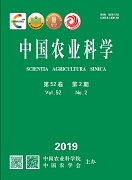【Objective】 The objective of this study is to determine the pathogens, dominant viruses, distributions of Solanaceae, Cucurbitaceae, Leguminosae, and Cruciferae vegetables viral diseases, and to analyze the expansion trend of some important viruses in China.【Method】 Viral disease survey and virus detection using a combination of serological and molecular biology methods on Solanaceae, Cucurbitaceae, Leguminosae, and Cruciferae vegetables were carried out in 31 provinces (municipalities, autonomous regions) of mainland China from 2013 to 2017.【Result】 A total of 41 653 suspected virus disease samples of Solanaceae, Cucurbitaceae, Leguminosae and Cruciferae vegetables were collected from the 31 provinces (municipalities, autonomous regions) across the country. A total of 63 viruses were detected, of which 40 viruses were detected in solanaceous vegetable crops, as well as 26 viruses in cucurbitaceous vegetable crops, 19 viruses in leguminous vegetable crops, and 14 viruses in cruciferous vegetable crops. Among them, 33 and 25 viruses were detected in pepper and tomato of solanaceous samples, respectively; 22 and 19 viruses were detected in pumpkin and cucumber of cucurbitaceous samples, respectively; 14, 12, 12 and 7 viruses were detected in cowpea, kidney beans, radish and Chinese cabbage, respectively. Mixed infections were common in the vegetable crops with two to six viruses respectively, most of the co-infected crops were infected with two viruses and some of the pepper, tomato and eggplant plants were infected with six viruses. Tomato mottle mosaic virus (ToMMV), Zucchini tigre mosaic virus (ZTMV), Pepper vein yellows virus (PeVYV), Pepper cryptic virus 1 (PCV-1) and Pepper cryptic virus 2 (PCV-2) were firstly recorded in China. ToMMV, Melon aphid-borne yellows virus (MABYV), Cucurbit aphid-borne yellows virus (CABYV) were firstly detected on pepper plants, ZTMV and Tobacco mild green mosaic virus (TMGMV) were firstly recorded on cucumber and pumpkin plants, respectively. While Tomato spotted wilt tospovirus (TSWV) was firstly detected on celery, Datura stramonium, cowpea, pea, Codonopsis pilosula, dahlia, Tropaeolum majus, Solanum indicum, and so on. Chilli veinal mottle virus (ChiVMV) was firstly found infecting Solanum yingjiangense. Meanwhile, pepper and tomato plants were found as the new natural hosts of Tobacco bushy top virus (TBTV). 【Conclusion】 Cucumber mosaic virus (CMV), Tobacco mosaic virus (TMV), Turnip mosaic virus (TuMV) and Broad bean wilt virus 2 (BBWV2) are the dominant viruses currently in China due to their widely distribution and serious damage on vegetable crops nationwide. Among them, CMV occurs in all of the 31 provinces (municipalities, autonomous regions), and is also the dominant virus in the all regions. CMV and TMV are the dominant viruses on solanaceous vegetable crops, while CMV, Zucchini yellow mosaic virus (ZYMV), Cucumber green mottle mosaic virus (CGMMV) and TMV are the dominant viruses on cucurbitaceous vegetable crops. CMV and BBWV2 are the dominant viruses of leguminous vegetable crops, and TuMV, CMV, TMV are the dominant viruses of cruciferous vegetable crops. Tomato chlorosis virus (ToCV), TSWV, CGMMV and ToMMV, which occurring seriously in some provinces and spreading rapidly, may have the risk of national epidemic.









